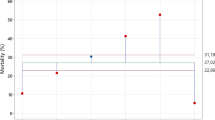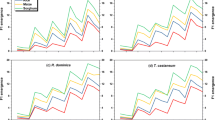Abstract
In many bulk-stored grain situations, Inert Dust Insecticides (IDI’s) have proven to be the most efficacious and cost-effective products to control insect pests and employ for the pre- and post-treatment of the empty storage facilities, silos and grain-handling equipment. In this study, a field trial was conducted to evaluate the insecticidal efficacy of an Iranian IDI, Dryasil, for bulk wheat storage protection over a nine month term. Before starting the field trial, a laboratory test was conducted to confirm the efficacy of the Iranian IDI, as compared to that of an established, commercial IDI product, Silicosec, against Trogoderma granarium Everts, Rhyzopertha dominica (F.), and Tribolium confusum Jacquelin du Val. For the field trial, wheat was stored in a 100-tonne concrete silo, which has a history of storage insect-pests infestations in recent years. Dryasil was applied as structural treatment at a rate of 2 g/m2 to the empty silo. The stored wheat received a 200 mm top-surface layer treatment and a 100 mm bottom layer treatment, both layers treated at a rate of 1 kg Dryasil/ton. Finally, the top surface was dressed with Dryasil at a rate of 100 g/m2. The effect of the treatment on the quality of the wheat at the end of the test period was also measured. The laboratory tests indicated that Dryasil and Silicosec have comparable efficacies against the tested species. The field trial demonstrated successful control of insect infestations for the 36 weeks storage term. The small increase in grain moisture content was a result of absorption from the more humid, ambient air. No adverse effects of Dryasil were detected on stored wheat properties.

Similar content being viewed by others
References
AACC International (2000) Approved Methods of the American Association of Cereal Chemists, The Association: St. Paul, MNUSA, 10th edition, Methods08-01, 10–10B, 44–15, 46–30, 54–10, 54–21, and 54–40A
Aydoğan S, Şahİn M, Akçacik AG, Hamzaoğlu S, Taner S (2015) Relationships between farinograph parameters and bread volume, physicochemical traits in bread wheat flours. J Bahri Dagdas Crop Res 3:14–18
Baliota GV, Athanassiou CG (2020) Evaluation of a greek diatomaceous earth for stored product insect control and techniques that maximize its insecticidal efficacy. Appl Sci 10:6441
Boxall RA (2001) Post-harvest losses to insects—a world overview. Int Biodeter Biodegr 48:137–152
Delgarm N, Ziaee M, McLaughlin A (2020) Enhanced-efficacy iranian diatomaceous earth for controlling two stored-product insect pests. J Econ Entomol 113:506–510
Dong NK, Van Ba N, Quy DN, Ngan LTK (2019) Extraction of gluten from wheat flour for manufacturing edible film. Hue Univ J Sci: Nat Sci 128:127–134
Ebeling W (1971) Sorptive dusts for pest control. Annu Rev Entomol 16:123–158
El-Sohaimy S, Shehata M, Mehany T, Zeitoun M (2019) Nutritional, physicochemical, and sensorial evaluation of flat bread supplemented with quinoa flour. Int J Food Sci Technol 2019: 1–15
Fields P, Korunic Z (2000) The effect of grain moisture content and temperature on the efficacy of diatomaceous earths from different geographical locations against stored-product beetles. J Stored Prod Res 36:1–13
Fields PG (1998) 14–19 October 1998) Diatomaceous earth: advantages and limitations. Paper presented at the Proceedings of the 7th International Working Conference on Stored-Product Protection, Beijing, China
Herron GA, Clift AD, White GG, Greening HG (1996) Relationships between insecticide use, grain hygiene and insecticide resistance in Oryzaephilus surinamensis (L.) (Coleoptera: Silvanidae) on grain-producing farms. J Stored Prod Res 32:131–136
Hill DS (2002) Pests: Class Insecta, Pests of stored foodstuffs and their control. Kluwer Academic Publishers, Springer, Malaysia, pp 135–316
Jackson K, Webley D (1994) Effects of Dryacide® on the physical properties of grains, pulses and oilseeds. Paper presented at the Proceedings of the 6th International Working Conference on Stored-Product Protection, CAB. Wallingford. Canberra, Australia
Korunic Z (2013) Diatomaceous earths: natural insecticides. Pesticidi i fitomedicina 28:77–95
Korunic Z, Fields PG, Kovacs MIP, Noll JS, Lukow OM, Demianyk CJ, Shibley KJ (1996) The effect of diatomaceous earth on grain quality. Postharvest Biol Tec 9:373–387
Korunić Z, Liška A, Lucić P, Hamel D, Rozman V (2020) Evaluation of diatomaceous earth formulations enhanced with natural products against stored product insects. J Stored Prod Res 86:101565
Korunić Z, Mackay A (2000) Grain surface-layer treatment of diatomaceous earth for insect control. Arh Hig Rada Toksiko 51:1–11
McLaughlin A (1994) Laboratory trials on desiccant dust insecticides. Paper presented at the Proceedings of the 6th International Working Conference on Stored-Product Protection, CAB. Wallingford, Canberra, Australia
Mhiko TA (2012) Determination of the causes and the effects of storage conditions on the quality of silo stored wheat (Triticum aestivum) in Zimbabwe. Nat Prod Bioprospect 2:21–28
Nayak MK, Daglish GJ (2018) Importance of stored product insects. In: Athanassiou CG, Arthur FH (eds) Recent advances in stored product protection. Springer Berlin Heidelberg, Berlin, Heidelberg, pp 1–17
Nayak MK, Daglish GJ, Phillips TW, Ebert PR (2020) Resistance to the fumigant phosphine and its management in insect pests of stored products: a global perspective. Annu Rev Entomol 65:333–350
Nickson PJ (1998) Maintaining stored organic wheat quality and condition. Paper presented at the Australian Postharvest Technical Conference, Canberra, Australia
Nickson PJ, Desmarchelier JM, Gibbs P (1994) Combination of cooling with a surface application of Dryacide® to control insects. Paper presented at the Proceedings of the 6th International Working Conference on Stored-Product Protection, Canberra, Australia
Opit G, Collins PJ, Daglish GJ (2012) Resistance management. In: Hagstrum DW, Phillips TW, Cuperus GW (Eds.), Stored Product Protection. United State, Kansas State University, pp. 143–156
Paponja I, Rozman V, Liška A (2020) Natural formulation based on diatomaceous earth and botanicals against stored product insects. Insects 11:613
Perišić V, Vuković S, Perišić V, Pešić S, Vukajlović F, Andrić G, Kljajić P (2018) Insecticidal activity of three diatomaceous earths on lesser grain borer, Rhyzopertha dominica F., and their effects on wheat, barley, rye, oats and triticale grain properties. J Stored Prod Res 75:38–46
Sagheer M, Asif MU, Ali Q, Zaman S (2020) Combined effect of diatomaceous earth and insect growth regulators against Trogoderma granarium (Coleoptera: Dermestidae). Sci Lett 8:55–60
Shah MA, Khan AA (2014) Use of diatomaceous earth for the management of stored-product pests. Int J Pest Manag 60:100–112
Sokal RR, Rohlf FJ (1995) Biometry: the principles and practice of statistics in biological research (Third ed.). FreedmanandCompany,NY
Snedecor GW, Cochran WG (1980) Statistical methods. Iowa State University Press, Ames, IA
Shewry PR (2009) Wheat. J Exp Bot 60:1537–1553
Stathers T, Riwa W, Mvumi B, Mosha R, Kitandu L, Mngara K, Kaoneka B, Morris M (2008) Do diatomaceous earths have potential as grain protectants for small-holder farmers in sub-saharan Africa? The case of Tanzania. Crop Prot 27:44–70
Stathers TE, Chigariro J, Mudiwa M, Mvumi BM, Golob P (2002) Small-scale farmer perceptions of diatomaceous earth products as potential stored grain protectants in Zimbabwe. Crop Prot 21:1049–1060
Stathers TE, Denniff M, Golob P (2004) The efficacy and persistence of diatomaceous earths admixed with commodity against four tropical stored product beetle pests. J Stored Prod Res 40:113–123
Stathers TE, Mvumi BM, Golob P (2002) Field assessment of the efficacy and persistence of diatomaceous earths in protecting stored grain on small-scale farms in Zimbabwe. Crop Prot 21:1033–1048
Ziaee M, Atapour M, Marouf A (2018) Persistence and efficacy of four iranian diatomaceous earths against three stored grains beetles. Proc Natl Acad Sci India Sect B Biol Sci 88:411–419
Ziaee M, Babamir-Satehi A (2019) Characterization of nanostructured silica as carrier for insecticides deltamethrin, pyriproxyfen, and chlorpyrifos and testing the insecticidal efficacy against Trogoderma granarium (Coleoptera: Dermestidae) larvae. J Econ Entomol 113:511–517
Ziaee M, Ebadollahi A, Wakil W (2021) Integrating inert dusts with other technologies in stored products protection.Toxin Rev1–16
Acknowledgements
We gratefully thank the staff of Shahid Darom Grain storage Silo for providing all needed facilities to conduct the experiment. The authors wish to thank Iranian Center of Cereal Research (ICCR) for their logistic support, Rheology and Chemistry laboratories of ICCR for their generous efforts on analysis of grain quality.
Author information
Authors and Affiliations
Corresponding author
Ethics declarations
Conflict of interest
The authors declare that they have no conflict of interest.
Additional information
Publisher’s Note
Springer Nature remains neutral with regard to jurisdictional claims in published maps and institutional affiliations.
Rights and permissions
Springer Nature or its licensor (e.g. a society or other partner) holds exclusive rights to this article under a publishing agreement with the author(s) or other rightsholder(s); author self-archiving of the accepted manuscript version of this article is solely governed by the terms of such publishing agreement and applicable law.
About this article
Cite this article
Ziaee, M., McLaughlin, A., Nasr, H.A. et al. Field study of the efficacy of an iranian inert dust insecticide on silo-stored wheat. Int J Trop Insect Sci 43, 419–427 (2023). https://doi.org/10.1007/s42690-023-00952-5
Received:
Accepted:
Published:
Issue Date:
DOI: https://doi.org/10.1007/s42690-023-00952-5




